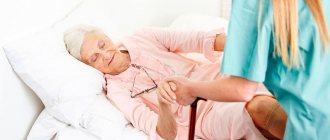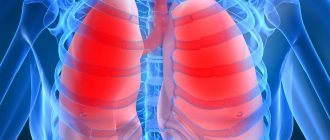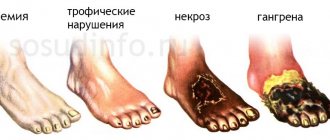About the disease
Stroke – translated means “strike, attack”, “paralysis” – an acute disturbance of blood circulation in the brain. The disease develops suddenly (from a few minutes to 1-2 days), manifests itself against the background of overexertion.
Reference. The first descriptions of the disease were made by Hippocrates back in 460 BC.
There are three types of disease:
- Ischemic stroke (up to 75–85% of cases), affects people over 60 years of age;
- Hemorrhagic stroke (up to 20%) occurs in people with hypertension aged 40–60 years;
- Subarachnoid hemorrhage (up to 5%) – rupture of an aneurysm, brain injury.
Important! Every 1-2 minutes, someone in Russia develops a stroke. Up to 80% of stroke survivors become disabled, 20–30% of them require constant care.
Swelling of paralyzed legs
After a stroke, the leg is paralyzed. The condition is often temporary; the leg will return to function after special therapy. Complications arise if the leg is swollen. The above illustrates the processes occurring latently in tissues.
If both legs swell, the phenomenon is an indicator:
- clamping of individual groups of large vessels;
- the presence of blockage of individual highways with cholesterol;
- loss of vascular elasticity;
- obstacles from the prolapse of internal organs (loss of abdominal muscle tone);
- poor conductivity of vessel walls.
The resulting swelling in the paralyzed leg illustrates other disorders:
- incorrect position of lying legs;
- disturbances in the communication of blood vessels during movement, a person does not feel the limb;
- violations of muscle tone.
On the part of loved ones, constant monitoring of the condition of the leg is required, ascertaining the reasons for the violation of the non-physiological position of the limb, and returning the normal position. If swelling is observed even after the recovery process, a series of tests are indicated. The main danger of this condition remains the formation of cancer cells under the pressure of constant metabolic disorders.
Why do limbs swell?
A stroke is a powerful blow to the left and right hemispheres of the brain, disabling not only the central nervous system, but the functioning of the entire organism as a whole.
If the cerebellum and right hemisphere, which is responsible for the physical functions of the body, are damaged, the patient experiences convulsions, swelling, numbness, sensitivity is lost, and paralysis of the limbs is possible.
This is why patients often complain that their legs are swollen.
This disease is terrible precisely because of its consequences - the functioning of the kidneys, heart, and genitourinary system is disrupted. Swelling of the legs (failure of fluid exchange) is a consequence of these disorders.
Important! Swelling of the legs appears within 1-2 hours after a stroke; emergency medical assistance is necessary to prevent a recurrence of the crisis.
Next we will tell you the specific reasons for the violation.
Heart failure
As a result of unstable heart function, limited blood supply to the legs or arms occurs. After a stroke, the heart muscle cannot cope with the volume of blood, and stagnation occurs. Reason: when the right side is affected, the blood, overflowing the veins, penetrates the tissues of the arms, legs and liver.
Varicose veins
After a stroke, the functioning of the entire circulatory system is disrupted - the vessels dilate, the walls fill with blood, become thin, as a result, the legs swell and greatly increase in size.
It is important to prevent the formation of blood clots by increasing the tone of the vessel walls and improving blood flow.
Thrombosis
After a stroke, with temporary paralysis, the patient practically does not move, and is always in a supine position. The blood stagnates and becomes thick not only in small capillaries, but also in the deep veins of the legs and arms. The cells “starve”, the limbs go numb, severe swelling occurs, accompanied by pain and bluish skin. People with varicose veins and other vascular diseases are especially at risk for thrombosis.
It is impossible to cure thrombosis on your own with massage or special exercises; urgent surgery is required (removal of a blood clot or installation of special filter devices that “catch” clots).
Kidney complications
After a stroke, the water balance is disrupted, the body can accumulate water, and dehydration is also possible. A distinctive sign is that not only the legs and arms swell, but also the face. The swelling is pale, warm, soft to the touch.
Possible necrosis and kidney failure; Inpatient treatment, special medications, and massage are required. Kidney prevention is very important.
When paralyzed
After a stroke, temporary immobilization of the right or left side is possible (sensitivity and muscle tone are impaired).
In this case, swelling of the paralyzed leg is a common occurrence.
Reasons why a paralyzed leg swells:
- Clamping of large vessels. When paralyzed, a person does not feel discomfort, cannot roll over, or change body position. And if a bedridden patient lies in one position for a long time, the vascular system is pinched, blood circulation is disrupted, and swelling appears.
- Stagnation of venous blood and lymph. The hanging position of the foot or hand is unacceptable - blood stagnates in the paralyzed limbs. The situation is aggravated by muscle weakness. As you know, muscle work ensures normal blood flow.
- Thrombosis. A distinctive feature is that the leg becomes hot, and pain occurs when lightly pressed. In this case, immediate assistance from a specialist is required.
Mechanisms of fluid metabolism disorders after stroke
After a stroke, the lower part of the body often swells. This is due to the process of damage to blood vessels during the actual impact. An acute transient disturbance in the blood circulation of the brain provokes a number of sudden changes affecting the legs.
Caring for a patient after a stroke
The understanding of metamorphosis lies in the symptoms preceding the impact:
- sudden attacks of weakness - the ongoing increase in the spasmodic state of blood vessels reduces the tone of the walls of the veins and capillaries, a feeling of buzzing in the legs;
- impaired understanding of speech, pronunciation of words - failures in communication pathways occur between parts of the brain, affecting other parts of the brain responsible for the unconscious processes of the body;
- impaired coordination, loss of balance, dizziness - increasing spasm provokes a sharp increase in the speed of movement of water media, synchronization dysfunction in one leg;
- fainting, loss of consciousness - a huge amount of hormones released into the blood provoke synoptic disturbances;
- sharp pain in the head - at the site of spasm, the pressure of fluids on the vessels increases;
- upcoming paralysis of half the face - damage to nervous activity in the area of cerebral hemorrhage, paralysis of the legs is possible.
Treatment
Treatment of leg swelling is carried out comprehensively; therapy includes taking medications, regular massage, and moderate exercises involving the limb. Only in combination these methods will help get rid of swelling and prevent complications.
Massage
Massage is an additional method of recovery after a stroke. Massage stimulates the functioning of blood vessels, accelerates blood flow, relaxes muscles, restores their strength, and relieves swelling.
Massage is prescribed in the first month of recovery. The course is long, at least 14-30 days, depending on existing complications, type of stroke, etc.
Important! In case of cerebral infarction without complications, massage is performed 2-3 days after the crisis; in case of hemorrhage - after 6-7 days.
Time of implementation : immediately after sleep, in the morning or before therapeutic exercises.
Duration – from 10 minutes, time gradually increases to 30 minutes.
Frequency day .
The entire course and number of sessions are prescribed by the doctor.
Carrying out conditions – air temperature not less than 20 ᵒС; Only the massaged part is exposed, the patient is covered with a blanket; massage is performed before meals or 2 hours after meals; after the massage – rest for 15 minutes.
Massage movements are directed from the foot to the knee, then to the inguinal lymph nodes. To quickly relieve swelling (to narrow blood vessels), massage is done with ice cubes, which include a decoction of oak bark and eucalyptus.
Additional remedies: cool gauze compresses (wrapped around the leg) are applied at night.
Gymnastics
Gymnastics is a prerequisite for relieving leg swelling.
To return the vessels to their previous state and normalize blood flow, feasible physical activity is necessary.
Time : in the morning after the massage.
Duration – at least 20 minutes.
Frequency – at least 2 times a day.
If possible, it is advisable to visit the pool and gym.
In the afternoon, exercise can be replaced by a walk. Fresh air, nature, positive emotions contribute to recovery.
For paralyzed limbs, passive gymnastics is performed.
Medicines
Attention! All medications are prescribed only by a doctor; self-medication is dangerous for the patient’s life.
In the initial stages, medications that thin the blood and prevent blood clotting (heparin, warfarin) are most often prescribed.
Diuretics - furosemide, torasemide, etc. can be used intravenously, intramuscularly and in tablets. Daily dose – from 10 mg. Negative consequences may occur - arrhythmia, exacerbation of heart disease.
For varicose veins, venotonics are added (detralex, phlebodia, etc.). For bedridden patients, an elastic bandage and special underwear are used.
Don’t forget about folk remedies - decoctions, baths, tinctures effectively relieve swelling:
- Carrot, cucumber, lemon juice are diuretics (drink 3 times a day before meals);
- To increase overall tone and quickly relieve swelling, it is recommended to mix the yolk with 3 grams of milkweed (use 2-3 times a day);
- Tincture of mint or flax relieves swelling after 3-4 days;
- Baths of mustard, sea salt and mint tone muscles and increase blood flow (every day before bed for 6 days).
Rate of vascular recovery after stroke
Treatment of the consequences of a stroke condition is kept under constant monitoring. The speed of vessel recovery remains an important factor. The resulting stress has an extremely serious impact on their condition.
To prevent constant swelling, it is recommended to monitor the composition of the blood and the accumulation of fluid in the tissues. Stimulating procedures put additional pressure on the arteries.
Without proper treatment, part of the vascular system may not recover at all. A return to normal will occur if you take vitamins and follow the rules of therapy, do massages in a timely manner, and put stress on the damaged areas of the limbs.
At home, some patients try not to use their damaged limbs. This leads to dystrophy of the muscular system. If the rules are followed, the vessels and arteries return to normal after a year and a half, fully beginning to fulfill natural duties.
Prevention
In order not to worsen the patient’s condition and prevent complications, immediately after a stroke you should take into account the necessary rules and recommendations:
- Fluid intake (in any form) is no more than 1 liter per day. The patient's urine should be excreted in the same volume;
- Diet (allowable amount of salt – 1.5 g per day);
- every 2 hours , at night - every 5 hours;
- It is unacceptable for limbs to hang from the bed (it is better to raise your legs and place them on a thick pillow);
- Massage and exercises should be performed regularly (even simple movements help restore blood circulation);
- In a sitting position, the back should rest on a backrest or support , pillows are placed under the arms, the position of the hands is palms down, fingers extended.
Useful video on the topic:
Clinic of manifestations of vascular blockage
The consequences of a stroke affect the condition of the body's blood vessels. A sharp jolt of blood flow at the time of crisis displaces a mass of tissue fluid, muscle fibers swell. The accumulation of liquid media provokes various pathological processes, especially the legs are modified.
The cause of leg swelling is the blockage of the artery by various types of deposits on the inner walls of the line. The further movement of blood flow becomes difficult, causing swelling of the legs.
Vessel blockage
The process is preceded by changes during a stroke:
- an abundance of hormones is released;
- under the influence of active substances, tissues become inelastic;
- body systems sharply increase the rate of metabolic reactions;
- a large number of chemical compounds are released into the blood;
- the blood flow rushes to the leg, bringing various decay products into the vessels.
At the moment of agony of brain activity, the body, in an attempt to protect itself from stress, dissolves part of the adipose tissue to obtain additional energy. A lot of fluid is released, filling the vessels. The media contain additional substances for the breakdown of fat cells. Cholesterol compounds settle on the inner walls of the blood vessels in the legs.











